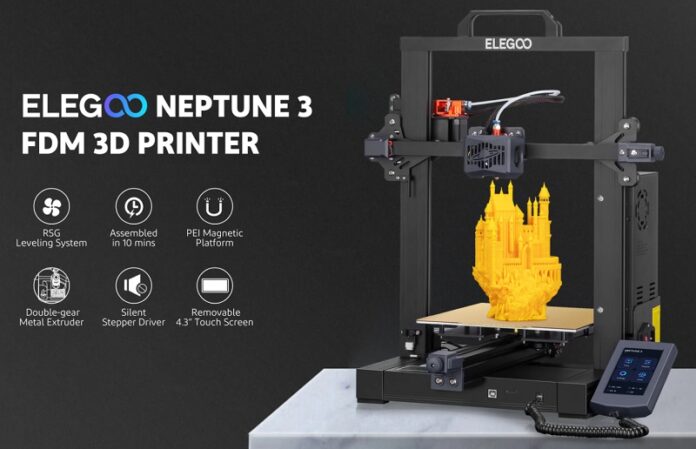The new ELEGOO NEPTUNE 3 provides all the available features in a low-budget FDM 3D printer. Since it is designed for beginners, it is easy to assemble, and everything is included for a quick start. With its 220*220*280mm build volume and a price of just $210, the third-generation Neptun can compete with most filament 3D printers in its market segment.
The double-gear metal extruder on the NEPTUNE 3 is the same design used on the Elegoo’s older machine, the Neptun 2S. In terms of temperatures, it’ll get up to 260°C, which makes it, in theory, compatible with most usual consumer filaments such as PLA, ABS, TPU, and PETG. Thanks to the PEI magnetic platform with a spring steel sheet provides in the same time good adhesion and easy removal of the 3D printed models.
The XYZ axis is driven by TMC2225, E0 axis is driven by TMC2209 with more stable motion performance and a lower printing noise of under 50db, like a person’s whisper. The solid metal frame has a portable handle and overhead gantry for maximum stability during printing for better print quality. The XY axis adopts the belt tension adjustment device with a hand-tightening nut to conveniently and quickly adjust the belt tightness.
Key features
- RSG levelling system: The 16-point RSG levelling system with a strain gauge pressure sensor on the print head to record the distance between the nozzle and the hotbed at each point. Once the sensor scans any tiny variations and unevenness, it will automatically compensate for each point by adjusting the Z-axis height to ensure the same distance between the print nozzles and the bed (about 0.1-0.2mm). And Neptune 3 comes with a larger build volume of 220x220x280mm than its predecessor.
- Reliable Extrusion System: The double-gear metal extruder is designed with a spring elasticity adjustment and a special titanium alloy throat pipe for smoother filament feeding and more stable & precise printing, significantly reducing the risk of nozzle clogging.
- Ultra-Quiet Printing: XYZ axis adopts TMC2225 silent driver and E0 axis of TMC2209 silent driver, which ensures more stable and smooth movement at a whisper-quiet below 50dBA. V-guide roller made of POM for stable and accurate motion, quieter, wear-resistance, and longer life.
- PEI Magnetic Platform: The PEI spring steel magnetic platform with a special coating features anti-warping and high stickiness, and you can remove printed models merely by bending the steel sheet. With a filament sensor, whenever filament runs out, breaks, or gets clogged, printing will pause until you load the filament and resume.
- Smart Resume Printing: No worry about unexpected power off as the printer can recover from the power outage and continue printing. With a filament sensor, whenever possible errors like filament runout, filament breakage, or filament blockage, the machine will stop work for resuming printing before the new filament feeds in. Neptune 3 also comes with a guide wheel structure to reduce the feeding resistance of consumables and noise generation.
- Removable Touchscreen: The 4.3-inch removable full-colour touch screen can be operated by hand-held or fixed on the base with an intuitive interface and step-by-step assistance, which is more convenient to operate and support multi-language freely switch.
Tehnical sepcifications
| Frame material | CNC machined aluminium extrusion |
| Dimensions | 625*472*507mm |
| Net weight | 10.35kg |
| Printing technology | FDM (Fused Deposition Modeling) |
| Print volume | 220*220*280mm |
| MAX. nozzle temperature | 260° Celsius |
| MAX. hotbed temperature | 100° Celsius |
| Filament compatibility | PLA, ABS, TPU, PETG, Wood, Marble, etc |
| Resume printing | Yes |
| Out of filament detection | Yes |


Hi! I was wondering if you could tell me what type of hot end fans the Neptune 3 takes? I seem to have a lot of issue finding parts for this particular printer. I love the Netune 3, don’t get me wrong, but I’ve owned it for 2 months and the front, hot end fan is going out already.
I love my NEPTUNE 3. I also have an Elegoo Mars 2 for fine details.
Please could someone share his Prusa slicer profile?
Thank you!
Martin
Hello Martin,
You should check here for Elegoo Neptun Prusaslicer settings https://github.com/andrewsuzuki/prusaslicer-elegoo-profiles
This printer looks like a dream! How it works the auto-bed-levelling?
Are there any decent sub $300 3d printers that would work for printing drone parts using tpu filaments?